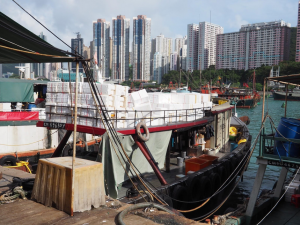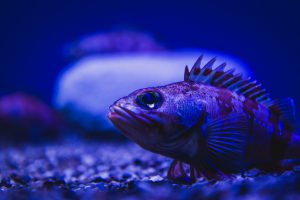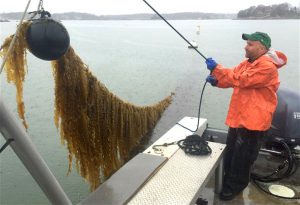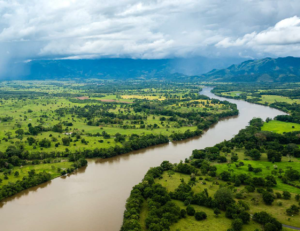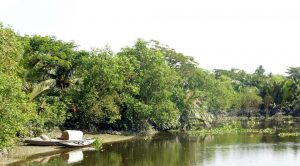Researchers in Hong Kong are trying to cut a major source of marine plastics: the ubiquitous polystyrene boxes used by the fishing industry.
Scientific studies indicate that polystyrene has a harmful effect on sea life and human health, but the fishing industry has been slow to act. The problem is that an alternative must match polystyrene’s ease of use and low cost if it’s to be adopted widely.
Polystyrene usually takes the form of a white foamy material known as styrofoam that is present in anything from food containers and coffee cups, to beanbags and insulation. It’s one of the world’s most ubiquitous materials with global production reaching 17.5 million tonnes in 2014, according to an industry report. Of this number, over 40% was consumed in the Asia Pacific region.
A toxic plastic
“If we could rid the world of one type of plastic, let it be polystyrene,” says Dr Chelsea Rochman, marine ecologist at the University of Toronto.
“Styrofoam is one of the most common items washing up on our beaches, it is not sustainable, there really are no arguments to keep using it.”
The problem starts with its production. It’s made from styrene and benzene, which are both known carcinogens, and then expanded into a foam. Toxic flame retardants are sometimes added too.
These elements are known to leach from the plastic when heated, which is why environmentalists have long advocated against using polystyrene in food packaging.
Health threat
Yasmin Rasjid is vice-chairman of a coalition of Malaysian Environmental Non-Governmental Organisations (MENGO), which campaigns against polystyrene packaging.
“In Malaysia we’re seeing city after city imposing bans on polystyrene in the food and grocery sector. One of the reasons why our campaign is so successful is because this is not an environmental issue, it’s a health issue. When people hear of the harmful elements leaching into their food they pay attention,” she says.
Rasjid says the ban has been reasonably effective but it only applies to the food sector, meaning polystyrene boxes are still found at some street food markets and in rural areas.
Another problem is dealing with the waste.
“In Malaysia, and in other members of ASEAN (Association of Southeast Asian Nations), we’re still very much struggling with a bad waste disposal network, so everyday plastics end up in the ocean. That is the bigger issue here,” says Rasjid.

A global problem
Around 80% of marine debris originates on land, according to the US-based campaign organisation Clean Water Action. Plastics make up 90% of the waste floating in our oceans, where it travels around the world along a system of major currents known as the five gyres.
Sun, salt and water erode the plastic, eventually breaking it down into tiny particles. These microplastics, now no larger than plankton, enter the marine food chain and make it all the way back to our dinner plates.
The United States Environmental Protection Agency has found styrene residue in 100% of sampled human fat tissue as far back as 30 years ago.
A recycling problem
Dealing with waste polystyrene is a problem though because no one wants to recycle it.
“It’s not that polystyrene is not recyclable,” says Bernard Merkx, honorary president of Plastics Recyclers Europe, an association of 120 industry members. “It’s that it has so little value. The weight and limited applicability just don’t make it worth the while.”
Polystyrene, especially the expanded (foamy) type, is just too light and too big to be recycled cost-effectively, says Dr Rochman. “Tipping fees for recycling go per pound. Expanded polystyrene takes up a lot of space, but it’s light, so the rate at which it is actually recycled is very low.”
Unrecycled plastic ends up in landfill but in countries with poor waste management it often finds its way to the ocean too. Considering the problem with recycling it, efforts are being directed at replacing the material instead.
Looking for alternatives
The World Wide Fund for Nature (WWF) Hong Kong is working with fishermen to test out an alternative plastic for the polystyrene boxes, which are used to store and transport their catch.
“A good, usable box sells for around 10 Hong Kong dollars (US$1.3). There is no new or old, just usable or unusable. If they’re decent quality, I’d say we use each one about eight times before they get thrown out,” says a fisherman in Hong Kong’s Aberdeen Harbour.
A ban on polystyrene packaging today is out of the question, says Patrick Yeung, the project leader for WWF Hong Kong.
“We’re trying to solve a problem, not create another problem for people. We need to find suitable alternatives for the fishermen, only then we can convince them not to use polystyrene. This way, the fishing communities will feel better about making the change, instead of seeing us as an evil organisation imposing laws on their lifestyles,” says Yeung.
Polystyrene boxes are lightweight, easy on the hands and cheap so a suitable alternative would have to be similar. Yeung’s team are also looking at the whole supply chain so they can integrate the recycling sector into the solution.
One plastic for another
Polypropylene is an alternative plastic that expands and insulates and which could replace polystyrene. Polypropylene boxes are more expensive to make but the plastic is favoured by recyclers, meaning used boxes would retain some value. According to recent data, less than 1% of post-consumer polypropylene is recycled yet annual demand in North America alone is approximately 450,000 tonnes, according to the Association of Plastics Recyclers.
There are many reasons why the recycling rate is so low, according to the International Solid Waste Association (ISWA). Chief among them is the extreme variability in the quality of recyclable material and inadequate collection infrastructure.
ISWA also points out that there is a lack of global quality standards, and virgin polypropylene is typically more affordable than the recycled variety, although this could change as more plastics are recycled.
This low recycling rate means a disproportionate amount of polypropylene still finds its way into the oceans. After a cleanup of beaches by the South China Sea in 2015, researchers found that nearly 60% of all small plastic debris was polypropylene.
So is it worth switching? Dr Chelsea Rochman sees several benefits. “First of all, as a material polypropylene is more inert. It is made of carbons and hydrogens, so it doesn’t leach toxins like polystyrene does.”
But if a switch to polypropylene does take place then it needs to happen in a context of improved recycling facilities and collection – otherwise it’s one form of plastic waste replacing another.
Dr Rochman notes there is a worldwide move away from expanded polystyrene and towards expanded polypropylene. “And as a consumer you can’t really tell the difference.” Expanded (foamy) polypropylene is already widely applied in the automobile industry and appreciated for its ease of use and ability to withstand minor impacts.
Bernard Merkx is also optimistic. “I believe we’re on the right track. The fishermen themselves will be the best judges of the quality of this proposal.
The first results have been positive; the fishing industry is very open to our suggestions. It is of course this industry that feels the impact of ocean pollution directly.”
Patrick Yeung agrees: “When these fishermen go out on the ocean, they can see the fragmented polystyrene surrounding them. Everyone realises there is a problem. They are willing to change. We just need to offer a solution.”
Roger King contributed reporting
